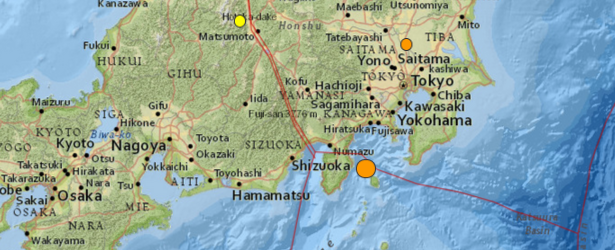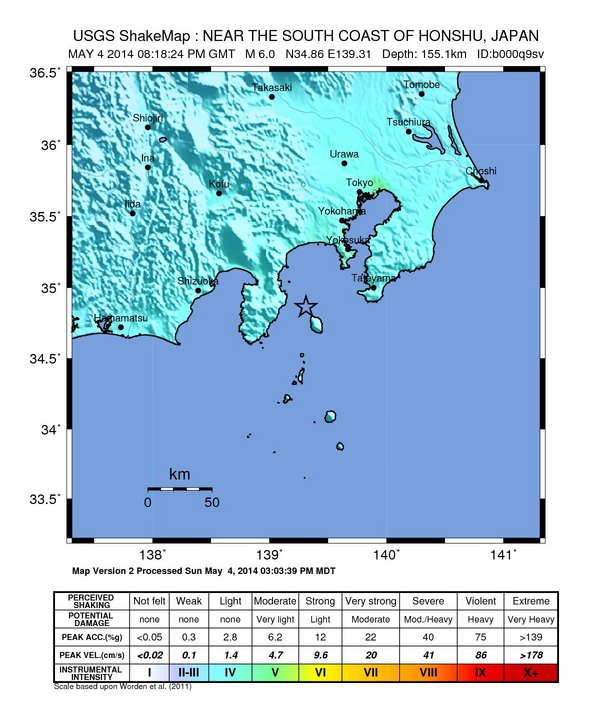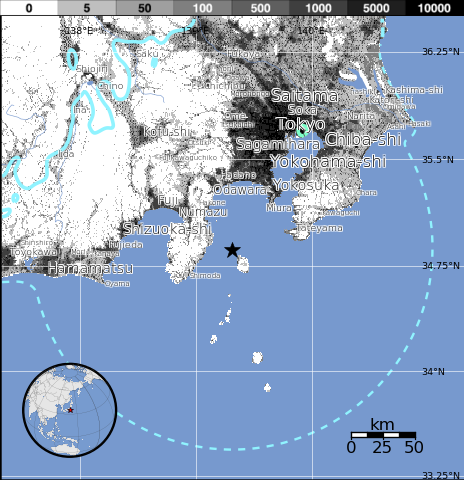Strong earthquake M6.2 rattles Tokyo vicinity, Japan

Strong earthquake measuring M6.2 (JMA) on the Richter scale struck near Tokyo, Japan on May 4, 2014 at 20:18 UTC (May 5, 2014 at 05:18 JST – local time). Japan Meteorological Agency reported depth of 160 km. Epicenter was located 23 km (14 miles) ESE of Ito and 98 km (61 miles) SSW of Tokyo, Japan.
This was the strongest earthquake registered in Tokyo since the 2011 Tohoku disaster.
USGS reported M6.0 earthquake at depth of 155.1 km (96.4 miles) and issued green alert for shaking-related fatalities and economic losses – there is a low likelihood of casualties and damage.
Although epicenter was located in the coastal area no tsunami watch, advisory or warning was in effect.
This was a subduction earthquake where the Pacific oceanic plate glides below the continental plate and sometimes hangs. When the energy gets too big, the locked section breaks and triggers an earthquake. (ER)
At least 17 people were injured in Kanto area:
9 people in Prefecture Tokyo
5 people in Kanagawa
2 people in Chiba
1 man in Saitama
JMA official said this quake was probably unrelated to the “big one” that experts predict will strike directly under Tokyo over the next 30 years.

Overall, the population in this region resides in structures that are resistant to earthquake shaking, though some vulnerable structures exist. Recent earthquakes in this area have caused secondary hazards such as landslides, fires, and liquefaction that might have contributed to losses.
Population exposure
Population per ˜1 sq. km. from LandScan

Selected cities exposed from GeoNames Database of Cities with 1,000 or more residents.
| MMI | City | Population |
|---|---|---|
| V | Urayasu | 144k |
| V | Ichikawa | 458k |
| IV | Miura | 51k |
| IV | Narashino | 156k |
| IV | Yokosuka | 429k |
| IV | Fujisawa | 395k |
| IV | Saitama | 1,193k |
| IV | Tokyo | 8,337k |
| IV | Yokohama-shi | 3,574k |
| IV | Shizuoka-shi | 702k |
| IV | Chiba-shi | 920k |
(k = x1,000)
Seismotectonics of Japan and Vicinity
Japan and the surrounding islands straddle four major tectonic plates: Pacific plate; North America plate; Eurasia plate; and Philippine Sea plate. The Pacific plate is subducted into the mantle, beneath Hokkaido and northern Honshu, along the eastern margin of the Okhotsk microplate, a proposed subdivision of the North America plate. Farther south, the Pacific plate is subducted beneath volcanic islands along the eastern margin of the Philippine Sea plate. This 2,200 km-long zone of subduction of the Pacific plate is responsible for the creation of the deep offshore Ogasawara and Japan trenches as well as parallel chains of islands and volcanoes, typical of Circumpacific island arcs. Similarly, the Philippine Sea plate is itself subducting under the Eurasia plate along a zone, extending from Taiwan to southern Honshu that comprises the Ryukyu Islands and the Nansei-Shoto trench.
Subduction zones at the Japanese island arcs are geologically complex and produce numerous earthquakes from multiple sources. Deformation of the overriding plates generates shallow crustal earthquakes, whereas slip at the interface of the plates generates interplate earthquakes that extend from near the base of the trench to depths of 40 to 60 km. At greater depths, Japanese arc earthquakes occur within the subducting Pacific and Philippine Sea plates and can reach depths of nearly 700 km. Since 1900, three great earthquakes occurred off Japan and three north of Hokkaido. They are the M8.4 1933 Sanriku-oki earthquake, the M8.3 2003 Tokachi-oki earthquake, the M9.0 2011 Tohoku earthquake, the M8.4 1958 Etorofu earthquake, the M8.5 1963 Kuril earthquake, and the M8.3 1994 Shikotan earthquake. (USGS) More information on regional seismicity and tectonics
Featured image: USGS

Commenting rules and guidelines
We value the thoughts and opinions of our readers and welcome healthy discussions on our website. In order to maintain a respectful and positive community, we ask that all commenters follow these rules:
We reserve the right to remove any comments that violate these rules. By commenting on our website, you agree to abide by these guidelines. Thank you for helping to create a positive and welcoming environment for all.